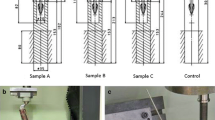Abstract
Background
No consensus exists as to whether to let patients bear weight or not after revision of a loosened hip prosthesis using morselized and impacted allograft bone and cement. In the original description of the method, the patients were advised not to bear weight for 3 months postoperatively. Theoretically, bone graft remodeling is enhanced by mechanical load, but an increased migration of the prosthesis within the graft can also be anticipated. In addition, practicing restricted weight-bearing is cumbersome for the patients.
Methods
The present study was initiated to evaluate the migration, as measured by radiostereometry analysis (RSA), in patients mobilized with unrestricted weight-bearing after a hip revision using the X-change Revision Instruments System. This group was compared with a previous series with restricted weight-bearing for the initial 3 months postoperatively. Seven stems and 12 sockets were evaluated by RSA over 2 years. Only patients without intraoperative complications were mobilized with unrestricted weight-bearing.
Results
All 7 stems migrated in the distal direction (median 2.6 mm; range 0.8–16.5 mm) and in the posterior direction (median 2.3 mm; range 0.7–22.1 mm). Eleven of the 12 sockets migrated in the proximal direction (median 2.5 mm; range 0.2–8.1 mm). The migration rate decreased gradually in all directions, but 3 stems and 5 sockets still migrated between the 1.5- and 2-year follow-ups. There were no significant differences in migration in any direction for either the stems or the sockets compared to the group with restricted weight-bearing.
Conclusion
No increased migration occurred in the group free to bear weight as compared to restricted weight-bearing. We shall continue to allow unrestricted weight-bearing in cases where the femoral bone feels competent to withstand the initial load. It simplifies the postoperative mobilization, and we speculate that it might increase the remodeling of the graft.



Similar content being viewed by others
References
Brewster NT, Gillespie WJ, Howie CR, Madabhushi SP, Usmani AS, Fairbairn DR (1999) Mechanical considerations in impaction bone grafting. J Bone Joint Surg Br 81:118–124
Buma P, Lamerigts N, Schreurs BW, Gardeniers J, Versleyen D, Slooff TJ (1996) Impacted graft incorporation after cemented acetabular revision. Histological evaluation in 8 patients. Acta Orthop Scand 67:536–540
Burchardt H (1983) The biology of bone graft repair. Clin Orthop 174: 28–42
Charnley J (1979) Low friction arthroplasty of the hip. Springer Verlag, Berlin Heidelberg New York
Eldridge JD, Hubble MJ, Nelson K, Smith EJ, Learmonth ID (1997) The effect of bone chip size on the initial stability following femoral impaction grafting. Annual meeting of European Orthopaedic Research Society, Barcelona, Spain
Enneking WF, Mindell ER (1991) Observations on massive retrieved human allografts. J Bone Joint Surg Am 73:1123–1142
Frost HM (1964) The laws of bone structure. Charles C. Thomas, Springfield, IL, USA
Gie GA, Linder L, Ling RS, Simon JP, Slooff TJ, Timperley AJ (1993) Impacted cancellous allografts and cement for revision total hip arthroplasty. J Bone Joint Surg Br 75:14–21
Gruen TA, McNeice GM, Amstutz HC (1979) 'Modes of failure' of cemented stem-type femoral components: a radiographic analysis of loosening. Clin Orthop 141:17–27
Gustilo RB, Pasternak HS (1988) Revision total hip arthroplasty with titanium ingrowth prosthesis and bone grafting for failed cemented femoral component loosening. Clin Orthop 235:111–119
Linder L (2000) Cancellous impaction grafting in the human femur: histological and radiographic observations in 6 autopsy femurs and 8 biopsies. Acta Orthop Scand 71:543–552
Nelissen RG, Bauer TW, Weidenhielm LR, LeGolvan DP, Mikhail WE (1995) Revision hip arthroplasty with the use of cement and impaction grafting. Histological analysis of four cases. J Bone Joint Surg Am 77:412–422
Ornstein E, Franzen H, Johnsson R, Sandquist P, Stefansdottir A, Sundberg M (1999) Migration of the acetabular component after revision with impacted morselized allografts: a radiostereometric 2-year follow-up analysis of 21 cases. Acta Orthop Scand 70:338–342
Ornstein E, Franzen H, Johnsson R, Sundberg M (2000) Radiostereometric analysis in hip revision surgery—optimal time for index examination: 6 patients revised with impacted allografts and cement followed weekly for 6 weeks. Acta Orthop Scand 71:360–364
Ornstein E, Franzen H, Johnsson R, Sandquist P, Sundberg M (2001) Results of hip revision using the Exeter stem, impacted allograft bone and cement. Clin Orthop 389:126−133
Selvik G (1989) Roentgen stereophotogrammetry. A method for the study of the kinematics of the skeletal system. Acta Orthop Scand [Suppl] 232:1–51
Slooff TJ, Buma P, Schreurs BW, Schimmel JW, Huiskes R, Gardeniers J (1996) Acetabular and femoral reconstruction with impacted graft and cement. Clin Orthop 323:108–115
Tägil M, Aspenberg P (2001) Fibrous tissue armoring increases the mechanical strength of an impacted bone graft. Acta Orthop Scand 72:78–82
Ullmark G, Hovelius L, Strindberg L, Wallner A (2000) Reduced bleeding through temporary balloon occlusion in hip and knee revision surgery. Acta Orthop Scand 71:51–54
Wang JS, Tägil M, Aspenberg P (2000) Load-bearing increases new bone formation in impacted and morselized allografts. Clin Orthop 378:274–281
Wolff J (1986) The law of bone remodelling. Springer Verlag, Berlin Heidelberg New York
Acknowledgements
This study was supported by the Region of Scania and the Swedish Medical Research Council (no. 17x-09509). We thank Agenta Nilsson for the radiographs necessary for RSA and Håkan Leijon for computerizing the RSA pictures.
Author information
Authors and Affiliations
Corresponding author
Rights and permissions
About this article
Cite this article
Ornstein, E., Franzén, H., Johnsson, R. et al. Hip revision with impacted morselized allografts: unrestricted weight-bearing and restricted weight-bearing have similar effect on migration. Arch Orthop Trauma Surg 123, 261–267 (2003). https://doi.org/10.1007/s00402-003-0499-7
Received:
Published:
Issue Date:
DOI: https://doi.org/10.1007/s00402-003-0499-7




